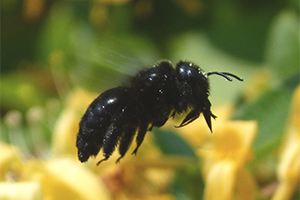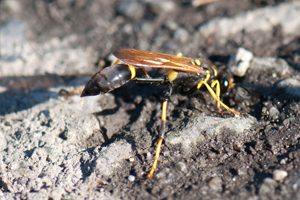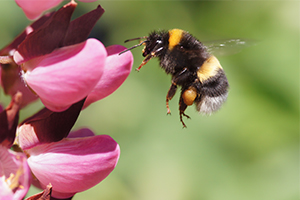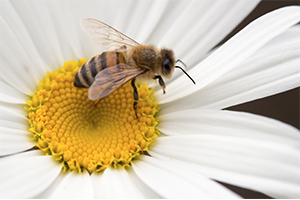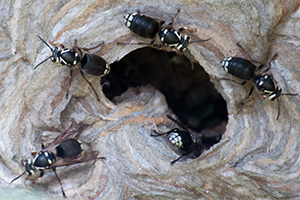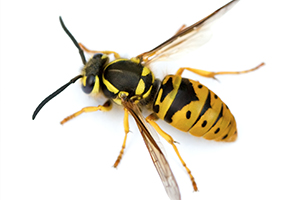Bees, Hornets & Wasps
Muhammad Ali said he could sting like a bee. Abraham Lincoln said that when he hears a man giving a speech, he likes to imagine the man is speaking at the same time he is fighting bees. Whatever the strange reference may be, bees have for centuries been know to help the environment while infesting yards, stinging predators and even causing the allergic troublesome reactions. Bees, Hornets, & Wasps are some of the most annoying insects because of their ability to bite and/or sting. At the same time, they are also one of the most beneficial insects with their ability to pollinate plants. Identification is important to determine the threat to people and the need for control. Some people are deathly allergic to stings and should be aware of the dangers that these insects pose. There are both solitary and social groups of these insects. Solitary species live independently of each other while the social species have a queen, workers and males. The most common solitary groups include: carpenter bees & mud daubers. The most common social groups are: bumble bees, honeybees, hornets, paper wasps and yellow jackets.
Carpenter Bees
These are the big black bees with a blue, black, green, or purple metallic color. They are about 1/2 to 3/4-inch-long and are slow clumsy flyers. They tunnel their way into exposed wood, usually redwood or cedar. Once inside the wood they make a 90-degree turn and hollow out a 3/8-inch tunnel to lay eggs. The carpenter bee will lay an egg, pack pollen, seal the cell and continue laying several more eggs. Once they have established a gallery, carpenter bees will continue to use it year after year. Males do not have a stinger while females rarely use their stinger. For prevention against carpenter bees, seal or paint all sides of trim, fascia and exposed wood. Direct treatment into the holes is the only way to kill the carpenter bees and eggs once infestation has occurred. Seal all holes or replace damaged wood once the bees have been killed to prevent further infestation the next year.
Mud Daubers
This solitary wasp makes a nest with multiple chambers from mud. The nests are usually found in a garage, on exterior siding, or under eaves. The mud dauber will lay an egg on a collected spider and seal the chamber. The egg will hatch, feed on the spider and emerge from the cell as an adult. When a nest is vacated, the tube chambers will be open. People are worried when they see these nests on their structures but daubers are beneficial because they kill spiders and rarely sting humans.
Bumble Bees
These bees are wide bodied and are usually black and yellow in color. They are beneficial for pollinating plants and flowers. They will not sting if left undisturbed. Bumblebees live in colonies like honey bees, and usually like to make nests underground in abandoned rodents nests, for example. Bumble bee colonies die in late fall, but they are very active in late Spring and all Summer long. These bees are very helpful in pollinating crops and flowers. Ironically, it has been said that bumble bees shouldn’t be able to fly due to their large body and smaller wing span; however, bumble bees sweep their wings more like an airplane’s technology, forcing air down to keep their bodies up. Their big bodies generate heat, which helps them fly in cooler temperatures than other bees.
Honeybees
The honeybee is a social insect that lives in large colonies from around 20,000 to 80,000 individuals. They are beneficial for making honey, beeswax and pollinating flowers and plants. The colony consists of one egg-laying queen, many workers (infertile females), and drones (males). The males mate and then die. When a honeybee stings, the barbed stinger, and several other internal parts are torn from the bee’s body. The bee soon dies thereafter. Only rarely will a honeybee colony encroach on humans. When it does happen, contact a bee-keeping club to see if they want the bees. If not, the bee colony can be eradicated.
Bald-Faced Hornets
The bald-faced hornet is a relative of the yellow jacket. Its name comes from its mostly black body and white face. Bald-faced hornets live in colonies and like to come out in late summer. They sting and are aggressive to anyone or anything that invades their space. Their nests are usually three or more feet off the ground, in trees, shrubs, utility poles, homes, sheds, building overhangs, and other building types.
Paper / Umbrella Wasps
The umbrella wasp gets its name from making small paper nests under eaves that resemble an overturned umbrella. The nest will usually contain around ten wasps but can grow in population to over two hundred. The nests have a single comb without a covering to protect the nest. There is no worker caste system and the queen is determined by the first to start laying eggs. The wasp is not usually aggressive but will buzz or sting an invader. They may become more of a nuisance during the fall when they sun themselves, in great numbers, on the warm side of a building or find their way inside.
Yellow Jackets
These insects can be easily identified by their yellow and black markings. They are about 3/8 to 5/8-inch in size. Workers can travel a half-mile from their nest, which makes it difficult to locate a colony that is invading a person’s property. Trapping can help lure them to other areas but has little effect on eliminating the population. The adults will feed on fruit juices and sweet material. During the summer the adults will collect insects and meat for the larvae of the expanding nest, which explains the large invasion of yellow jackets around barbeques and patios. At the end of the season males are produced to mate with queens and die. The fertile queens usually find their way into a structure to over winter the cold weather.

